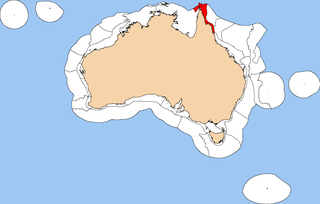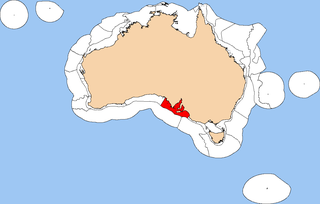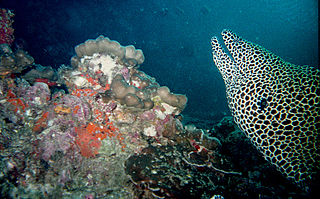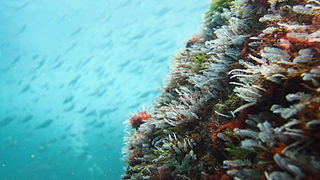Related Research Articles

A biome is a distinct geographical region with specific climate, vegetation, and animal life. It consists of a biological community that has formed in response to its physical environment and regional climate. Biomes may span more than one continent. A biome encompasses multiple ecosystems within its boundaries. It can also comprise a variety of habitats.

An ecoregion is an ecologically and geographically defined area that is smaller than a bioregion, which in turn is smaller than a biogeographic realm. Ecoregions cover relatively large areas of land or water, and contain characteristic, geographically distinct assemblages of natural communities and species. The biodiversity of flora, fauna and ecosystems that characterise an ecoregion tends to be distinct from that of other ecoregions. In theory, biodiversity or conservation ecoregions are relatively large areas of land or water where the probability of encountering different species and communities at any given point remains relatively constant, within an acceptable range of variation . Ecoregions are also known as "ecozones", although that term may also refer to biogeographic realms.

A biogeographic realm is the broadest biogeographic division of Earth's land surface, based on distributional patterns of terrestrial organisms. They are subdivided into bioregions, which are further subdivided into ecoregions. A biogeographic realm is also known as "ecozone", although that term may also refer to ecoregions.
The Global 200 is the list of ecoregions identified by the World Wide Fund for Nature (WWF), the global conservation organization, as priorities for conservation. According to WWF, an ecoregion is defined as a "relatively large unit of land or water containing a characteristic set of natural communities that share a large majority of their species dynamics, and environmental conditions". For example, based on their levels of endemism, Madagascar gets multiple listings, ancient Lake Baikal gets one, and the North American Great Lakes get none.

The Tropical Eastern Pacific is one of the twelve marine realms that cover the coastal waters and continental shelves of the world's oceans. The Tropical Eastern Pacific extends along the Pacific Coast of the Americas, from the southern tip of the Baja California Peninsula in the north to northern Peru in the south. It is bounded on the north by the Temperate Northern Pacific realm, and on the south by the Temperate South America realm.

Tweed–Moreton, also known as the Central Eastern Shelf Transition, is a marine biogeographic region of eastern Australia.

The Northeast Shelf Transition is a biogeographic region of Australia's coastal and continental shelf waters. It includes the tropical coastal waters of the northern Great Barrier Reef and the Torres Strait in northeastern-most Australia. It is a provincial level bioregion in the Integrated Marine and Coastal Regionalisation of Australia (IMCRA) system. It corresponds to the Torres Strait and Northern Great Barrier Reef marine ecoregion in the WWF's Marine Ecoregions of the World system.

The Southeast Shelf Transition is a biogeographic region of Australia's coastal and continental shelf waters. It covers a portion of Australia's southeastern coast, from southern New South Wales to eastern Victoria, including the islands of the Kent Group and Furneaux Group at the eastern end of the Bass Strait. It is a provincial level bioregion in the Integrated Marine and Coastal Regionalisation of Australia (IMCRA) system, and is a transitional region between the warm temperate Central Eastern Shelf Province to the northeast and the cool temperate Bass Strait Shelf and Tasmanian Shelf provinces to the west and south. It corresponds to the Cape Howe marine ecoregion in the WWF's Marine Ecoregions of the World system.

The Spencer Gulf Shelf Province, also known as the South Australian Gulfs marine ecoregion, is a biogeographic region of Australia's continental shelf and coastal waters. It includes the warm temperate coastal waters of South Australia's central coast. It is a provincial bioregion in the Integrated Marine and Coastal Regionalisation of Australia (IMCRA) system.

The Western Bass Strait Shelf Transition is a biogeographic region of Australia's coastal and continental shelf waters. It is a transitional region between the cold-temperate Bass Strait Shelf and Tasmanian Shelf provinces and the warm-temperate Spencer Gulf Shelf Province. It is a provincial bioregion in the Integrated Marine and Coastal Regionalisation of Australia (IMCRA) system. It is the southern portion of the Western Bassian marine ecoregion in the World Wildlife Fund's (WWF) Marine Ecoregions of the World system.

The Western Indo-Pacific is a biogeographic region of the Earth's seas, comprising the tropical waters of the eastern and central Indian Ocean. It is part of the larger Indo-Pacific, which includes the tropical Indian Ocean, the western and central Pacific Ocean, and the seas connecting the two in the general area of Indonesia. The Western Indo-Pacific may be classified as a marine realm, one of the great biogeographic divisions of the world's ocean basins, or as a subrealm of the Indo-Pacific.

The Central Indo-Pacific is a biogeographic region of Earth's seas, comprising the tropical waters of the western Pacific Ocean, the eastern Indian Ocean, and the connecting seas.

The Temperate Northern Pacific is a biogeographic region of the Earth's seas, comprising the temperate waters of the northern Pacific Ocean.

Temperate Southern Africa is a biogeographic region of the Earth's seas, comprising the temperate waters of southern Africa, where the Atlantic Ocean and Indian Ocean meet. It includes the coast of South Africa and Namibia, and reaches into southern Angola. It also includes the remote islands of Amsterdam and Saint-Paul, to the east in the southern Indian Ocean.

Temperate South America is a biogeographic region of the Earth's seas, comprising the temperate and subtropical waters of South America, including both the Pacific and Atlantic coasts of the continent and adjacent islands. It also includes the remote Gough Island and Tristan da Cunha in the South Atlantic Ocean.

Temperate Australasia is a biogeographic region of the Earth's seas, comprising the temperate and subtropical waters of Australia and New Zealand, including both the Indian Ocean and Pacific coasts of the continent and adjacent islands.

The Eastern Indo-Pacific is a biogeographic region of the Earth's seas, comprising the tropical waters around island groups in the central Pacific Ocean. It includes most of Polynesia, except for New Zealand and the Kermadec Islands. It also includes the Marshall Islands and Kiribati from Micronesia. It adjoins the Central Indo-Pacific realm to the west, which encompasses Melanesia and the other island groups of Micronesia.

The Temperate Northern Atlantic is a biogeographic region of the Earth's seas, comprising the temperate and subtropical waters of the North Atlantic Ocean and connecting seas, including the Mediterranean Sea, Black Sea, and northern Gulf of Mexico.
References
- 1 2 3 4 Spalding, Mark D., Helen E. Fox, Gerald R. Allen, Nick Davidson et al. "Marine Ecoregions of the World: A Bioregionalization of Coastal and Shelf Areas". Bioscience Vol. 57 No. 7, July/August 2007, pp. 573–583.
- ↑ "MEOW digital ecoregions layer: ArcGIS Shapefile download link". Archived from the original on 2012-07-19. Retrieved 2010-12-03.
{{cite web}}: CS1 maint: unfit URL (link) - ↑ Briggs JC (1974) Marine Zoogeography. McGraw-Hill, New York, USA
- ↑ Olson DM, Dinerstein E. 2002; "The Global 200: priority ecoregions for conservation"; Annals of the Missouri Botanical Garden 89: 199-224

